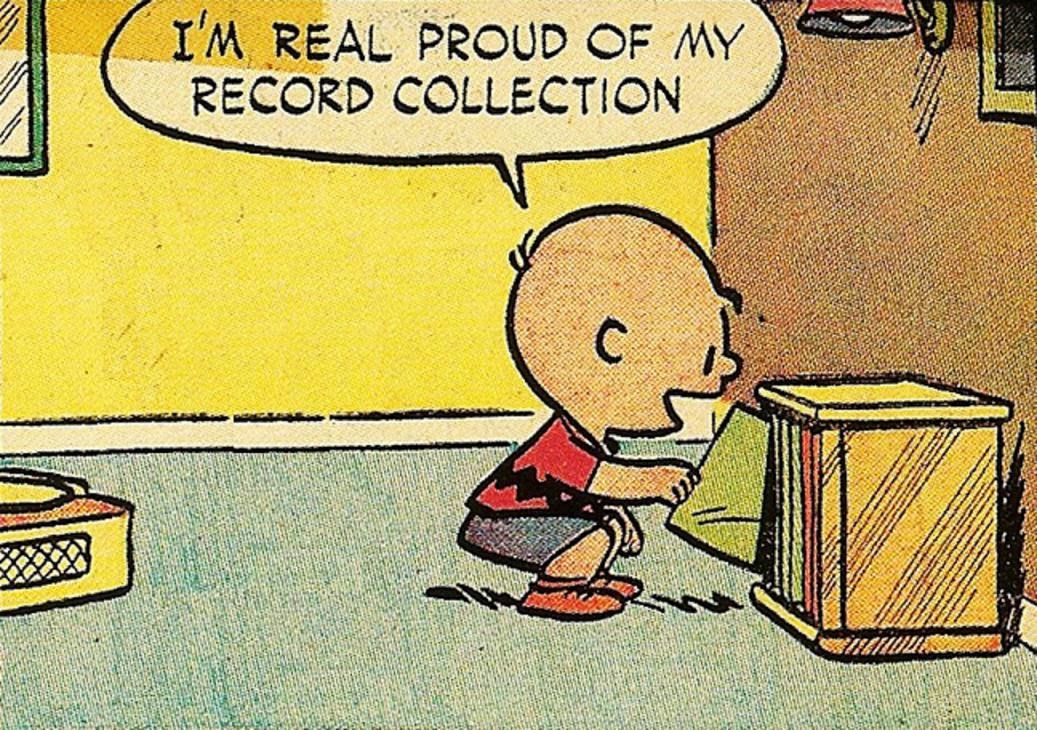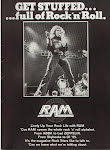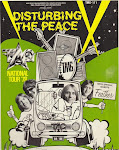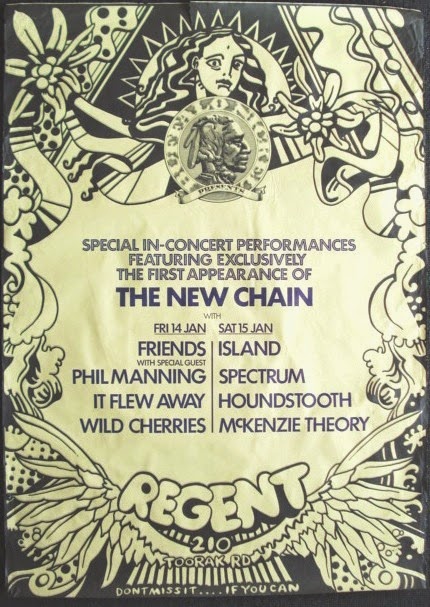.
The electric guitar is the ignition, spark and combustion of rock & roll, the very backbone of its existence. Those who wield it are inevitably drawn by a symbolic representation of power, freedom and seemly ultimate expression while those who master the instrument with any degree of individual expertise tend to reap a reward of almost disproportionate adulation and cultural prominence.
Guitar fascination is a peculiarly male domain, for reasons which encompass the physical shape, dominant stance and sheer energy potential. Schoolboys are inevitably drawn toward guitar 'heroes' while school girls are usually more concerned with a singer's cherubic face.
Adolescent influences invariably mold the style of any guitarist and such influences can be clearly identified as belonging to a few certain players and periods. For many of the participants in this collection, Shadow's leader Hank B.Marvin exemplified every virtue of the electric guitar with his straight forward but inventive approach. For other, younger players it was Jimi Hendrix' unorthodox, groundbreaking use of the axe which left them stunned and eager to imitate. Eric Clapton, Jeff Beck, Jimmy Page and other products of the mid-60's British R&B boom, have also been objects of admiration for notable guitarists of the 70's.
As is every other sphere of achievement, Australia has produced some truly superb guitarists. Some have failed to realise the full extent of their potential, either because of our antipodean isolation of our universal inferiority complex; while others have found (and will!) become recognised internationally for their skills.
"This album represents but eleven of Australia's hundred's of prominent guitarists - each unique in style from the others. All have been allowed the freedom to continue in or step outside of, their usual scope of performance and the result are exciting to the extreme" (Notes by Glenn A. Baker)
This album's uniqueness is the fact that most of the featured guitarists put a band together just for the album. This results in some interesting line-up combinations not seen before. Below is a transcript of the linear notes that came with this album and so each artist's biography is only current to 1977.
After twenty years of dedication to the craft, the amazing Kevin Borich looks set to finally realise his dream of international fame. As early as 1959, 12 year old Borich was making private recordings on his parent's New Zealand orchard farm, with two young girls from a neighbouring poultry farm. In 1964, he joined The Mergers and cut his teeth on the Auckland school-football club dance circuit. The Mergers evolved into The La De Das and Kevin regularly cycled 20 miles to rehearsals.
Within a year The La De Das were the hottest young R&B group in the country, with a residency at the famed Platterack Club and an eventual string of six consecutive top 5 hit singles. In 1967 the group moved base to Australia and were instantly acclaimed for their consummate musicianship. They remained a respected entity, despite increasing lineup changes, until 1975 with Borich as leader for the final four years. Since then he has fronted his own Kevin Borich Express and greatly increased his legion of devotees.
 Kevin is an exceptionally enigmatic guitarist who has influenced many an emerging young player with his almost classic machismo rock pose. The Borich style was moulded by early American R&B and even today he considers himself to be 'just a blues player' and still features such classics as "Little Red Rooster" in his stage act. To his eternal credit, Kevin has always remained loyal to tight, tough rock 'n' roll and refused to compromise his stance for commercial success, though current American awareness of his recent album and tour seems likely to bring rewards on his own terms.
Kevin is an exceptionally enigmatic guitarist who has influenced many an emerging young player with his almost classic machismo rock pose. The Borich style was moulded by early American R&B and even today he considers himself to be 'just a blues player' and still features such classics as "Little Red Rooster" in his stage act. To his eternal credit, Kevin has always remained loyal to tight, tough rock 'n' roll and refused to compromise his stance for commercial success, though current American awareness of his recent album and tour seems likely to bring rewards on his own terms.Kevin's recording legacy, which is well worth unearthing, comprises 8 fine albums, a dozen rare singles and assorted one off obscurities on live festival albums etc.
 Mario Millo
Mario MilloMario's father taught him the skills of Mandolin when only 5 and the guitar at 8. By 10 he was the star of floor shows with Lionel Long's band at Canley Vale's Village Nightclub, bringing home an enormous $12 a week. At 11 (1966) he joined his first rock band, the Beatles influenced The Wanted and a year later was leading The Menu in Blacktown (Sydney).
Gigging after school and on weekends, The Menu drew a huge legion of fans throughout Sydney's western suburbs and eventually won the 1969 2SM-Pepsi Pop Poll.
Renamed The Clik, Mario and friends cut two moderately successful singles before dissolving around 1971. When old friends Sebastian Hardie reformed (after the loss of Jon English) in 1973 they invited Mario to front them, having long been impressed by his advanced musical abilities and aspirations. Two highly acclaimed albums and one hit single "Rosanna" later, Mario Millo emerged as a highly individual guitarist with a leaning toward bold electronic experimentation.
"My playing expresses words without my having to actually say them, it is a totally emotional style" explains Mario. "My heroes are people like Hank Marvin (The Shadows), my father and This Van Leer (Focus) but my mentor is Jan Akerman (Focus)"
Throughout 1977 Mario toured Australia as Windchase and cut another superb album - Symphinity. He then locked himself away in his own 8 track suburban studio to create and record, the most notable result being the soundtrack album to Against The Wind and the national number one single Six Ribbons. Lately he has been appearing on stage with Jon English and is about to participate in the reformation of Sebastian Hardie (to meet an enormous Japanese demand for new recorded product). Mario is not really sure why his instrumental contribution to this album is titled "Rebecca"; "it seems to conjure up images of Spain and Rebecca sounds very Spanish to me" he suggests.
 Ian Moss
Ian MossIan, born and raised in Alice Springs, began classical piano training when 8 years old. By 12 he had lost interest and so turned to electric guitar; an event which coincided with the emergence of Jimi Hendrix and an entire new concept of rock guitar playing. He was invited to join the ranks of local hotshots The Scene, as rhythm guitarist and, a year later (at 15), started his own band Anger & Tears.
In 1972, when 17, Ian moved to Adelaide for scholastic reasons and, upon meeting keyboard player Don Walker, formed what would become Cold Chisel. The group's heavy metal blues entrenched them as Adelaide heroes and, after short successful tours into the Eastern states early in 1976, they moved base to Sydney at the end of the year. By the end of 1977 Cold Chisel were signed to WEA and have subsequently captured fearsome national prominence via two exceptional power rock albums.
Ian's influence comes from two areas - the blues of such masters as B.B.King and Muddy Waters and the heavy metal of Beck, Blackmore & Page, which he grew up with. "I suppose I lean toward the English heavy rock style" he concludes, "but I also admire jazz-rock players like Bill Connors and Al Di Meola from Return to Forever"
"The Dummy", Ian's contribution to this album, is actually a Cold Chisel track, with his lead vocals, rather than Jimmy Barnes. The virtuosity displayed in this fiery funk sound is almost incongruous with his tender age of just 24.
 Chris Turner
Chris TurnerPrimal rock and roller Chris Turner began his career in native England when just 12 years old. As a member of the Shadows-imitating Concerts, he paid his dues in seedy dives along with fellow beginners such as David Bowie, Peter Frampton and Steve Marriott. When 17, Chris lugged his massive 50 watt amp to New Zealand, where he resided for five years (during which time he learned to play foxtrots and rumbas, as leader of a show band).
In 1970 Chris made his way to Australia and, after tiring of the money treadwheel, turned his energies toward the creation of Drain in 1973 - one of Australia's first true punk groups. After three years of unrewarded raunch, Buffalo invited him to replace the departing Karl Taylor and he participated in the recording of their final album 'Average Rock & Roller'.
Since the beginning of 1978, Chris has been pounding through Sydney's rock haunts with The Chris Turner Band. He has also backed Rockwell T.James on tour and served two months in Rose Tattoo. Chris' playing is heavily influenced by his idols Hank B.Marvin, Chris Green (Fleetwood Mac) and Jeff Beck and he describes his contribution to this collection as "straight ahead tough rock & roll, nothing more".
 Lobby Loyde
Lobby LoydeLobby comes closer than any other contender to being Australia's greatest guitar hero. He is one of the few true legends of Australian rock and has used his innovative talent to influence the direction of music in this country.
He first came to light in Brisbane in 1966 as Barry Lyde, leader of the incredible Purple Hearts. The Hearts were raw, exciting and dynamic but no more so than their leader, who was single handily exploring the realms of guitar as a means of violent, aggressive expressions. By 1967 he had turned Melbourne's respected jazz cum rock band The Wild Cherries into a visually charismatic, musically anarchistic and relentlessly experimental rock unit - not unlike Detroit's Stooges or MC5. Their handful of singles (notably "That's Life") were bizarre excursions into a musical void, which both influenced and amazed peers.
At the beginning of the 70's, Lobby joined forces with ex teen idol Billy Thorpe and, with the classic The Hoax Is Over album, commenced an entire new chapter of Australian rock history. After teaching Billy to play guitar, Lobby returned as a short lived three piece lineup of The Wild Cherries, put down the much over looked George Guitar album and then fronted Brisbane's Coloured Balls (formed by old Purple Hearts associates Mick Hartley & Bob Darnes.
Resplendent in skinhead haircuts, The Coloured Balls wreaked heavy rock havoc from 1971 to 1974, with such mighty powerhouse singles as "Liberate Rock" and "Mess Of Blues". Then, after a 1976 album Obsecration, Lobby departed for England, where he still resides.
 |
| Mick Elliott (2006) |
Mick may not be a household name as an Australian guitarist but among those with a knowledge of antipodean rock he is held in high regard as an uncompromisingly rough, heavy rock guitarist.
Elliot's professional career began in 1966 as a member of Melbourne's Moppa Blues band with Rick Springfield. When Andy James departed the legendary Running Jumping Standing Still in 1968, Mick stepped in and led the rock outfit until its demise. He emerged again in the early 70's in the hard rock band Sid Rumpo and participated in their album for Mushroom Records.. In 1975 he formed the much under rated Wild Beaver Band, which drew a sizable cult following on the Melbourne pub circuit , and the following year he became the mainstay of Jim Keay's Southern Cross. Since 1978, Mick has been calling his own shots out front of The Mick Elliott Band and recently joined up for a stint in Western Flyer. In The Cards is characteristic of Mick's guts 'n' all style and it is a worthy inclusion in this collection.
Russell Smith
Russell first turned onto Dylan and blues as a 17 year old schoolboy and whiled away much of his adolescence in such Melbourne blues clubs as Bastille and Blues On Stag. With friend John De Bois (later in the Dingoes) he formed The Circle Of Love during flowery 1967, playing secondhand Hendrix riffs and trusty R&B. A year later he graduated to the Black Panther Blues Band, rendering Bobby Bland / B.B King type Chicago blues. A year later he was a budding teen idol, along with later soloist Gill Robert, in the 'three gigs a night for $90' 1968. Later in 1969 he joined Ray Arnott in the last formation of CamPact, the nucleus of which eventually evolved into Co.Caine.
The highly acclaimed but commercially unrewarded Co.Caine cut one fine album (Product of a Broken Reality) and expired during 1973. Russell spent 9 months in Mighty Kong with Ross Hanaford & Wilson and switched to guitar tutoring in Melbourne, while composing the score for the Rainbow Farm film.
A reunion with singer Gulliver Smith in Metropolis during 1975 led to a reformation of Co.Caine and another fine innovative album - Dr. Chop. This lasted for just 9 months so Russell returned to teaching, where he ran into Ross Hanaford, who invited him to join Billy T. After two minor hit singles the outfit fell into disarray and Russell split to Sydney to join the short lived Leo De Castro band.
Radioactivity was written some years ago as a protest against the French nuclear tests in the Pacific. It was recorded by the eventual 3rd lineup of Billy T (which disintegrated before any major product could be released) and features four guitar tracks - one slide, one straight lead, one lead with octave divider and one rhythm. It's a very funky offering but, as Russell himself puts it, "you can't stay in Sydney for long without getting into funk"
 Ian Miller
Ian MillerThe pin-up poster physical appearance of 27 year old Ian Miller tends to belie his status as a fine, inventive guitarist. His professional career began in Melbourne around 1968/69 with the Basin Street Blues Band and continued on through Langford Lever, Chetarca and the Wild Beaver Band.
Between 1973 and 1976 Ian worked as house producer at EMI (Melbourne) and was responsible for quality rock product by Jim Keays, Stuart & McKay, The Colored Balls and Skylight. His stunning sound achievement on the Moir Sister's 'Good Morning, How Are You?' has earned him a coveted 'Producer Of The Year' award in 1974.
Ian's guitar interest extends to jazz and classical music and Jeff Beck, John McLaughlin and Keith Richards are amongst those whom he admirers, From 1976 to 1978 Ian attended Melbourne's Conservatorium for Music for studies on musical theory, an indication of the seriousness with which he takes his playing.
For the past year, Ian has been in choice musical company as a member of John Paul Young's All Stars. For his contributions to this album he has exhumed and newly recorded The Old Money Blues, a song written some six years ago.
 Phil Manning
Phil Manningapart from Erol Flynn, Phil just may be the only truly notable export of Tasmania. He emerged from the Apple Isle as a gangly, youthful guitarist hopeful around 1966 and made his way to 'discotheque city' - Melbourne. There he became gainfully employed as a member of The Blue Jays and The Laurie Allen Revenue before being taken on as leag guitarist by ex-Brisbane blues outfit The Bay City Union. After one single, Manning linked up with Perth blues band The Beaten Track, late in 1968. This outfit evolved into Chain early in 1969, with the addition of ex-James Taylor Move vocalist Wendy Saddington.
 Phil Manning remained the mainstay of Chain from 1969 to 1973, as some of Australia's finest rock/blues musicians passed through its ranks. His name became synonymous with BLUES, of the finest integrity and quality. A lucid, flowing style of blues guitar endeared him to serious rock fans and enabled him to win countless guitar polls throughout the late 60's and early 70's. When Muddy Waters Blues Band visited
Phil Manning remained the mainstay of Chain from 1969 to 1973, as some of Australia's finest rock/blues musicians passed through its ranks. His name became synonymous with BLUES, of the finest integrity and quality. A lucid, flowing style of blues guitar endeared him to serious rock fans and enabled him to win countless guitar polls throughout the late 60's and early 70's. When Muddy Waters Blues Band visited After Chain finally breathed its last, Manning passed through a variety of relatively unsatisfying formations, such as Pilgrimage, Friends, Might Mouse and Band Of Talabone. Signed to Mushroom Records as the Phil Manning Band in 1975, he began to re orientate his direction to a more straight forward rock vein and has since recorded a solo album with Rainbird Records.
 Rockwell T.James and Harvey James
Rockwell T.James and Harvey JamesThe acquisition of a $20 Barclay guitar in 1969 commenced the career of, then, 16 year old Harvey James Harrop. While working at Allen's Music Store in Melbourne, Harvey honed his skills in a succession of long-forgotten amateur rock outfits. By 1972 he was working in Sailor with fellow guitarist Mick Elliott (also featured herein) and a year later both players were offered gigs with Mississippi. Harvey accepted and spent a year with the group, which included a trip to England. In May 1974 Mike Rudd invited him to join Ariel, where he remained until he successfully auditioned as Clive Shakespeare's replacement in Sherbet early in 1976. Harvey's tasty and adventurous style has been influenced by Clapton and Hendrix during his fledgling years and, of late, by Amos Garrett and Larry Carlton.
Rockwell T.James (no relation at all) is the rock 'n' roll non de plume for Ron Peel, a battle-scarred version of Oz rock. Rockwell's amazing professional career commenced in 1965 in the ranks of the incredible Missing Links and went on to include The Mystics, The (NZ) Pleasers, The Ray Brown Group, Leo & The Browns and in 1968, the first version of Rockwell T.James & The Rhythm Aces.
D
 uring 1970-71 he worked in England as bassist for Thunderclap Newman and upon his return, after stints with One Ton Gypsy and a Doug Parkinson Band, joined Kevin Borich in the fiery 3 piece La De Das. It was in this band, from 1972 to 1975, that Rockwell drew considerable acclaim for his powerful vice-tight style. In 1976 he followed Borich into the All Stars, backing John Paul Young and is currently still in such employ. An early single (Come On Home) under Ron's old pseudonym has led to a full tome recording career as Rockwell T.James and even a national tour under his own banner.
uring 1970-71 he worked in England as bassist for Thunderclap Newman and upon his return, after stints with One Ton Gypsy and a Doug Parkinson Band, joined Kevin Borich in the fiery 3 piece La De Das. It was in this band, from 1972 to 1975, that Rockwell drew considerable acclaim for his powerful vice-tight style. In 1976 he followed Borich into the All Stars, backing John Paul Young and is currently still in such employ. An early single (Come On Home) under Ron's old pseudonym has led to a full tome recording career as Rockwell T.James and even a national tour under his own banner.Harvey and Rockwell's contribution to this set was laid down during the sessions for Rockwell's album and features both guitarists trading off against each other, with the Sherbet rhythm section backing.
Australia in September 1973, guitarist James 'Pee Wee' Madison was so impressed with Manning's inherent understanding of the blues, he consented to record an album with Chain (Two Of A Kind).
This post consists of FLACs ripped from my mint condition vinyl - purchased back in 1979 when the album was first released. Full artwork for both vinyl and CD are also included along with label scans. Thanks to Greg Noakes for some of the great photos displayed here.
My main interest in the album at the time was focused on the tracks by Kevin Borich and Ian Moss, however I quickly discovered that there was a lot more talent on this album than I first realised. This is truly a Who's Who of great Aussie axemen and should not missed.
Track Listing:
01 Kevin Borich - "End of Me"
Guitar/vocals - Kevin Borich
Drums - Barry Harvey
Bass - Harry Brus
02 Mario Millo - "Rebecca"
Guitar - Mario Millo
Drums - Greg Henson
Bass - Jacky Orszaczky
Piano - Peter Kenny
03 Ian Moss - "The Dummy"
Guitar/vocals - Ian Moss
Drums - Steve Prestwich
Bass - Phil Small
Piano - Don Walker
04 Chris Turner - "Rock and Roll Man"
Guitar/vocals - Chris Turner
Drums - Geoff Plummer
Bass - Lindsay Osbourne
05 Lobby Loyde - "John's Song
"Guitar - Lobby Loyde
Drums - Clive Edwards
Bass - Billy Kristian
06 Mick Elliott - "On the Cards"
Guitar - Mick Elliott
Drums - Noel Herridge
Bass - Ian Ferguson
Piano - Ian Mason
07 Russell Smith - "Radioactivity"
Guitar - Russell Smith
Drums - Mick Holden
Bass - John Rees
Organ - Neil Macpherson
08 Ian Miller - "Old Money Blues"
 Guitar/vocals - Ian Miller
Guitar/vocals - Ian MillerDrums - Mark Kennedy
Bass - Duncan Maguire
piano - Frank Esler-Smith
Arp Synthesiser - Mark Opitz
09 Phil Manning - "Turkey Trot"
Guitar/vocals - Phil Manning
Drums - Trevo Courteney
Bass - Paul Wheeler
Piano - Ian Mason
10 Rockwell T. James - "Let it Go"
Rhythm Guitar - Rockwell T. James
Lead Guitar - Harvey James
Bass - Tony Mitchell
Drums - Alan Sandow
Elect. Piano - Garth Porter
.
Australian Guitar Album FLACs (250Mb) New Link 02/05/2020
.





















Photo you have against Mick Elliot is NOT him.. thats Rob Searles from Sid Rumpo
ReplyDeleteOK - I've fixed this. Hard to find a photo of Mick from the 70-80's, so I've had to use a current photo.
DeleteAny clue who has the Aussie guitar?
ReplyDeleteBecause Tasmania is included, I'm guessing that the cover is simply a clever graphic. Keep in mind they didn't have Photoshop back in 79' so this is a great effort
ReplyDelete